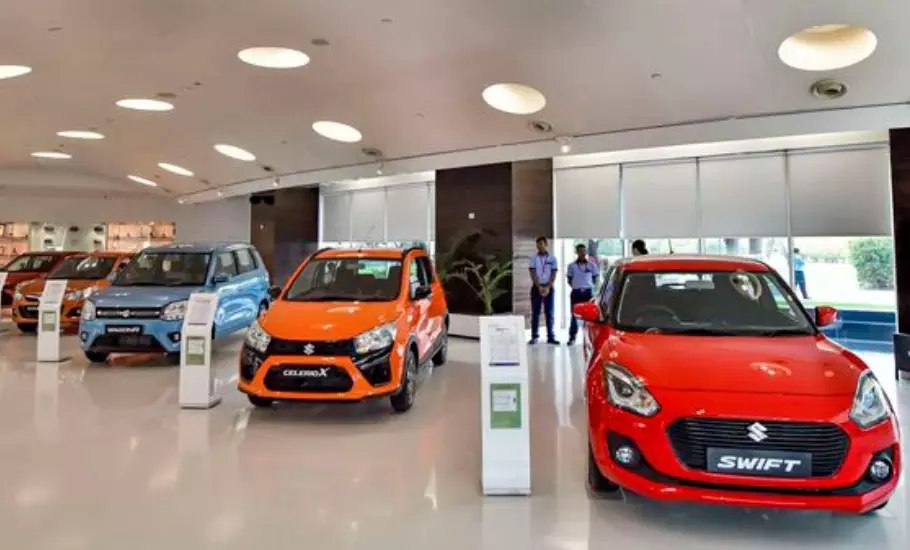
Market leader for 40 years, Maruti Suzuki grapples with mid-life crisis
While the carmaker has remained at the top despite its market share sliding for a while now, its biggest challenge comes from the increasing popularity of SUVs, where its share is an abysmal 11%

Maruti Suzuki, at 40, is facing a mid-life crisis, with its market share sliding to an eight-year low at 41.3 per cent, but if it is of any consolation, the share is still nearly three times higher than its nearest competitor.
While some critics point out that the market share represents the company’s lowest in eight years, Maruti Suzuki’s financial health tells a different story. Over the past decade, the company has witnessed a consistent profit growth of around 12 per cent, along with a stock price Compounded Annual Growth Rate (CAGR) of 20 per cent. This reflects a solid increase in the company’s profitability and market valuation. For the fiscal year 2022-23, Maruti Suzuki reported a net profit of Rs 8,211 crore, marking a 112 per cent increase from the previous year. Suzuki Motor Corporation owns 56.21 per cent of the company.
Its nearest competitor, Hyundai Motor, is in its 27th year of operations and holds a 14.6 per cent market share. Its next competitor, Tata Motors’ passenger car division, started operations 32 years ago and owns a 13.9 per cent share.
Leads hatchback sales
One of the reasons that Maruti Suzuki has been able to retain its top position in the passenger car market is its low-priced hatchback cars, which make it hard for the rest to compete in the same market. It owns a 72 per cent market share in the hatchback segment with four models.
The Wagon R, in particular, is the bestseller in this segment, contributing significantly to the company’s dominance. Additionally, the Baleno leads the premium hatch segment with a 52 per cent share, underlining Maruti Suzuki’s strong position in the small car passenger car market with a countrywide service that is hard to match in scale. Puneet Gupta, director for automotive forecasting at market research firm S&P Global Mobility, highlights that Maruti helped build the automobile ecosystem in India. This involved establishing suppliers for mass manufacturing and introducing Japanese quality and discipline in business operations.
Harshvardhan Sharma, head of auto retail practice at Nomura Research Institute, notes that Maruti Suzuki’s contribution to making India a formidable market is unparalleled. Their approach has been symbiotic, with the company's performance almost acting as a macroeconomic indicator of the Indian economy.
Over the years, Maruti has tried reinventing itself, bifurcating some of its best-sellers but low-end passenger cars from the premium. It launched a separate entity called Nexa to showcase premium cars such as Baleno, XL6, Grand Vitara, and others. It also innovated with technology, like the SHVS (Smart Hybrid Vehicle by Suzuki) and Automated Manual Transmission (AMT) systems, which enhanced fuel efficiency and consumer appeal. Moreover, Maruti has strategically targeted different market segments and regions, focusing strongly on urban and rural markets.
Its global tie-up with Toyota Motor Corporation has come in handy for the car maker. The recently launched Grand Vitara hybrid, similar to the Toyota Urban Cruiser Hyryder, has been a runaway success.
SUV challenge
While the carmaker has remained at the top despite its market share sliding for a while now, its biggest challenge comes from the increasing popularity of SUVs, where its share is an abysmal 11 per cent. Competitors like Hyundai, Kia and Mahindra & Mahindra are way ahead of Maruti Suzuki because they sensed the opportunity much earlier and were better positioned to roll out the cars in this segment faster.
While Grand Vitara is bringing in numbers, it is mainly because Toyota has yet to scale up the production of Urban Cruiser Hyryder, which is a similar product. Brezza, Jimny and the Fronx are the other compact SUVs in its portfolio, but they have yet to have much success.
Another hole in its portfolio is the lack of electric cars, which its competition is again well ahead in the race. During the Auto Expo 2023, the company announced its plans to launch its first electric vehicle, the eVX, by 2025. The eVX, an electric SUV, will be the first in a line of six electric models Maruti Suzuki plans to introduce by 2030 and will compete directly with models like the Mahindra XUV400 and Tata Nexon EV.
In a recent interview, Maruti Suzuki Chairman Subodh Bhargava emphasised that despite the challenges, the company’s understanding of the Indian consumer and the trust it has built over the years gives it a solid foundation to maintain market share and adapt to new market trends. The next decade will perhaps be the most difficult for the car maker as it will need a completely new template with agility and resilience as its main drivers to sustain its market share.

